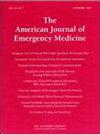Using ice packing and the polar life pod to treat severe hyperthermia
IF 2.2
3区 医学
Q1 EMERGENCY MEDICINE
引用次数: 0
Abstract
Introduction
Cold water immersion (CWI) is the fastest method of reducing body temperature of exertional heatstroke (EHS) patients. Treatment delays and/or an inability to quickly cool EHS patients with CWI before or while enroute to hospitals are common contributors to EHS morbidity and mortality. CWI in ambulances and emergency departments (ED) is challenging since they often lack CWI equipment (e.g., tubs). Recently, clinicians demonstrated excellent EHS patient outcomes using CWI with body bags (BAGS). However, using BAGS with CWI in ED creates other challenges (e.g., medical staff slipping, drainage). Ice packing with BAGS may quickly reduce body temperature and resolve these issues. We measured rectal temperature (TREC) cooling rates with three ice masses and no added water in the Polar Life Pod (PLP), a body-bag-like device.
Methods
Twelve subjects (8 males, 4 females; age:22 ± 3y; mass:71.9 ± 10.6 kg; ht.:170.2 ± 7.3 cm) exercised in the heat (wet bulb globe temperature = ∼27 °C) until TREC was ≥39.75 °C. They laid in PLP while ∼9 kg (SMALL), ∼27 kg (MEDIUM), or ∼ 53 kg (LARGE) of nugget ice was poured into PLP. Cooling stopped when TREC was 38.25 °C.
Results
TREC cooling rates increased as ice mass increased (SMALL:0.15 ± 0.05 °C/min; MEDIUM:0.19 ± 0.07 °C/min; LARGE:0.27 ± 0.10 °C/min, P < 0.001). Minimal water was created from ice melting (SMALL: 3.8 ± 1.1 L; MEDIUM: 5.3 ± 2.1 L; LARGE: 4.9 ± 2.2 L, P = 0.07).
Conclusions
Ice packing in the PLP quickly reduced TREC and resolved many of the challenges of treating EHS in ED and ambulances. The PLP portability, small space footprint, and effectiveness suggest it can be implemented while enroute to ED, potentially reducing the morbidity and mortality caused by lengthy treatment delays.
使用冰敷和极地救生舱来治疗严重的体温过高
摘要冷水浸泡是降低劳役性中暑(EHS)患者体温最快的方法。治疗延误和/或无法在前往医院之前或途中迅速冷却患有CWI的EHS患者是导致EHS发病率和死亡率的常见原因。救护车和急诊科(ED)的CWI具有挑战性,因为它们通常缺乏CWI设备(例如浴盆)。最近,临床医生证明了使用CWI与尸袋(bags)的EHS患者的良好效果。然而,在急诊科使用bag和CWI会带来其他挑战(例如,医务人员滑倒、引流)。冰敷袋可以迅速降低体温,解决这些问题。我们在极地生命舱(PLP)中测量了直肠温度(TREC)的冷却速率,该装置是一种类似身体袋的装置,有三个冰块,没有添加水。方法12名受试者(男8名,女4名,年龄22±3岁,体重71.9±10.6 kg,身高170.2±7.3 cm)在高温(湿球温度= ~ 27°C)下进行锻炼,直到TREC≥39.75°C。将~ 9公斤(SMALL)、~ 27公斤(MEDIUM)或~ 53公斤(LARGE)的金块冰倒入PLP中。TREC为38.25℃时停止冷却。结果strec冷却速率随冰块质量的增加而增加(SMALL:0.15±0.05°C/min; MEDIUM:0.19±0.07°C/min; LARGE:0.27±0.10°C/min, P < 0.001)。融冰产生的水最少(SMALL: 3.8±1.1 L; MEDIUM: 5.3±2.1 L; LARGE: 4.9±2.2 L, P = 0.07)。结论:在PLP中加入冰块可以迅速降低TREC,解决急诊和救护车中EHS治疗的许多挑战。PLP的便携性、占地面积小和有效性表明,它可以在前往ED的途中实施,潜在地降低了因长时间治疗延误造成的发病率和死亡率。
本文章由计算机程序翻译,如有差异,请以英文原文为准。
求助全文
约1分钟内获得全文
求助全文
来源期刊
CiteScore
6.00
自引率
5.60%
发文量
730
审稿时长
42 days
期刊介绍:
A distinctive blend of practicality and scholarliness makes the American Journal of Emergency Medicine a key source for information on emergency medical care. Covering all activities concerned with emergency medicine, it is the journal to turn to for information to help increase the ability to understand, recognize and treat emergency conditions. Issues contain clinical articles, case reports, review articles, editorials, international notes, book reviews and more.

 求助内容:
求助内容: 应助结果提醒方式:
应助结果提醒方式:


